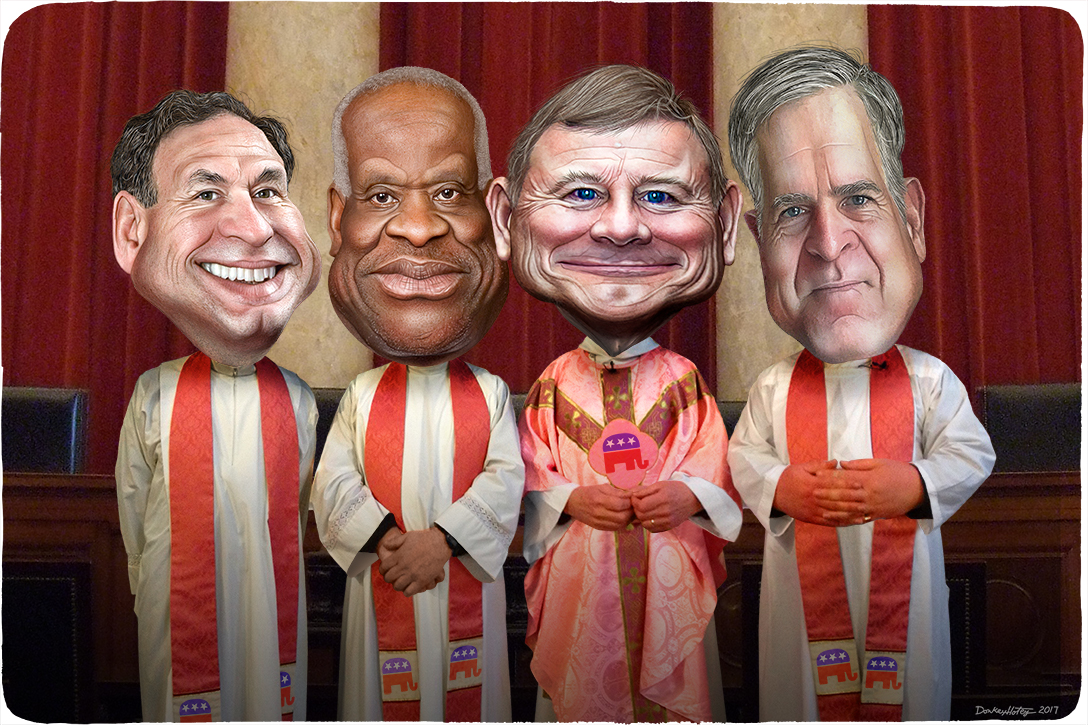John Roberts And The Erosion Of Church-State Separation: Will He Go Further?

Table of Contents
Roberts's Track Record on Church-State Cases
Chief Justice Roberts's tenure has witnessed several significant cases impacting the interpretation of the Establishment Clause and Free Exercise Clause. Understanding his past rulings provides crucial insight into his potential future actions.
-
Carson v. Makin (2022): This case involved Maine's tuition assistance program, which excluded religious schools. The Court, with Roberts in the majority, ruled in favor of the religious schools, arguing that excluding them violated the Free Exercise Clause. This decision broadened the scope of religious freedom, potentially opening the door for increased public funding of religious institutions.
-
Kennedy v. Bremerton School District (2022): This case concerned a football coach who engaged in on-field prayer. The Court, again with Roberts's support, ruled in favor of the coach, arguing his actions were protected by the Free Exercise Clause. This decision raised concerns about the Establishment Clause, as it potentially allows for government endorsement of religion in public spaces.
Bullet Points:
- Key Rulings & Impact: Both Carson and Kennedy significantly expanded the interpretation of the Free Exercise Clause, potentially at the expense of the Establishment Clause.
- Legal Arguments: The majority opinions emphasized the individual's right to religious expression, while dissenting opinions highlighted the potential for government entanglement with religion.
- Prevailing Viewpoints: A clear conservative majority on the Court shaped these decisions, reflecting a shift in the interpretation of the First Amendment's religion clauses.
- Long-Term Consequences: These rulings could lead to increased litigation challenging the separation of church and state in various public sectors, including education and government employment.
The Shifting Landscape of Religious Freedom
The Supreme Court's approach to religious freedom is not occurring in a vacuum. Broader societal and political changes significantly influence its decisions.
-
Political Polarization: Increasing political polarization has heightened the salience of religious issues, making them a focal point of partisan debate. This polarization influences public opinion and, indirectly, impacts judicial decisions.
-
Conservative Legal Movements: The rise of conservative legal movements and think tanks has played a significant role in shaping the legal arguments presented before the Court and influencing judicial appointments. These groups actively advocate for a broader interpretation of religious freedom.
Bullet Points:
- Societal Shifts: The increasing visibility of religious expression in public life, coupled with heightened concerns about religious discrimination, has contributed to the changing landscape.
- Political Pressure: Judicial decisions are not immune to political pressure. Public opinion and political discourse can influence the Court's approach to controversial issues.
- Interest Groups & Lobbying: Well-organized interest groups and lobbying efforts play a significant role in shaping the Court's agenda and influencing the arguments presented in key cases.
Predicting Future Decisions: Will Roberts Move Further Right?
Predicting future Supreme Court decisions is inherently complex. However, analyzing Chief Justice Roberts's past rulings and judicial philosophy offers some insight.
-
Potential Future Cases: Cases involving religious exemptions from anti-discrimination laws, school prayer, and the role of religion in public education are likely to arise in the coming years.
-
Roberts's Judicial Philosophy: While generally considered a conservative justice, Roberts has sometimes shown a preference for incremental change. However, the current composition of the Court may embolden him to embrace more significant shifts.
Bullet Points:
- Potential Future Cases: Expect challenges to existing regulations impacting religious practices in various contexts.
- Roberts's Philosophy: His emphasis on judicial restraint may be challenged by the Court's conservative majority.
- Potential Alliances: Roberts's alliances with other conservative justices will determine the direction of future decisions.
- Potential Impact: A continued erosion of church-state separation could have profound implications for American society, impacting education, employment, and the public square.
Conclusion
Chief Justice John Roberts's influence on church-state separation cases has been profound. His decisions, often reflecting a conservative majority, have demonstrably expanded the scope of religious freedom, potentially at the expense of the Establishment Clause. The shifting political landscape and influence of conservative legal movements contribute to this trend. Whether Roberts will continue to push the Court further right remains to be seen, but the potential consequences of a further erosion of the separation of church and state are significant and warrant careful consideration. We urge readers to engage further with this critical issue. Research the cases mentioned, participate in informed civic discussions, and contact your representatives to express your concerns. Learn more about the First Amendment and church-state relations by visiting [link to relevant resource, e.g., ACLU website]. The future of church-state separation depends on informed and engaged citizens.

Featured Posts
-
 Orta Afrika Cumhuriyeti Ile Bae Arasinda Imzalanan Ticaret Anlasmasinin Detaylari
May 02, 2025
Orta Afrika Cumhuriyeti Ile Bae Arasinda Imzalanan Ticaret Anlasmasinin Detaylari
May 02, 2025 -
 Find The Winning Numbers For Lotto Lotto Plus 1 And Lotto Plus 2
May 02, 2025
Find The Winning Numbers For Lotto Lotto Plus 1 And Lotto Plus 2
May 02, 2025 -
 Fortnite Servers Down Extended Outage Delays Chapter 6 Season 2 Launch
May 02, 2025
Fortnite Servers Down Extended Outage Delays Chapter 6 Season 2 Launch
May 02, 2025 -
 Viral Cat Posts Cause Upheaval Among Kashmir Cat Owners
May 02, 2025
Viral Cat Posts Cause Upheaval Among Kashmir Cat Owners
May 02, 2025 -
 Gratis New York Times Via Nrc De Reden Achter De Actie
May 02, 2025
Gratis New York Times Via Nrc De Reden Achter De Actie
May 02, 2025
